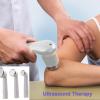CYBERMED LIFE - ORGANIC & NATURAL LIVING
CYBERMED LIFE - ORGANIC & NATURAL LIVING
 Ultrasound therapy: Therapeutic ultrasound refers generally to any type of ultrasonic procedure that uses ultrasound for therapeutic benefit. This includes HIFU, lithotripsy, targeted ultrasound drug delivery, trans-dermal ultrasound drug delivery, ultrasound hemostasis, cancer therapy, and ultrasound assisted thrombolysis It may use focused ultrasound (FUS) or unfocused ultrasound.
Ultrasound therapy: Therapeutic ultrasound refers generally to any type of ultrasonic procedure that uses ultrasound for therapeutic benefit. This includes HIFU, lithotripsy, targeted ultrasound drug delivery, trans-dermal ultrasound drug delivery, ultrasound hemostasis, cancer therapy, and ultrasound assisted thrombolysis It may use focused ultrasound (FUS) or unfocused ultrasound.
Ultrasound is a method of stimulating the tissue beneath the skin's surface using very high frequency sound waves, between 800,000 Hz and 2,000,000 Hz, which cannot be heard by humans.
There is little evidence that active ultrasound is more effective than placebo treatment for treating patients with pain or a range of musculoskeletal injuries, or for promoting soft tissue healing.
Relatively high power ultrasound can break up stony deposits or tissue, accelerate the effect of drugs in a targeted area, assist in the measurement of the elastic properties of tissue, and can be used to sort cells or small particles for research.
There are three potential effects of ultrasound. The first is the increase in blood flow in the treated area. The second is the decrease in pain from the reduction of swelling and edema. The third is the gentle massage of muscle tendons and/ or ligaments in the treated area because no strain is added and any scar tissue is softened. These three benefits are achieved by two main effects of therapeutic ultrasound. The two types of effects are: thermal and non thermal effects. Thermal effects are due to the absorption of the sound waves. Non thermal effects are from cavitation, microstreaming and acoustic streaming.
Cavitational effects result from the vibration of the tissue causing microscopic bubbles to form, which transmit the vibrations in a way that directly stimulates cell membranes. This physical stimulation appears to enhance the cell-repair effects of the inflammatory response.